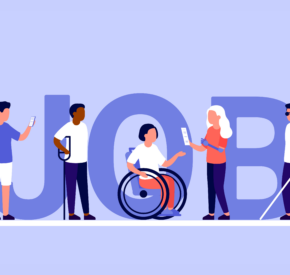Accessible Text Fonts

By Nick Tamburino
What is an Accessible Text Font? Why Does it Matter?
The aim of an accessible text font is to impede as little as possible the reading speed and the comfortability in reading of the user in consideration of a potential user’s variable abilities and preferences, and to remain in compliance with US Web Content Accessibility Guidelines (enforced through section 508 of the Rehabilitation Act of 1973).
An accessible font will consider the kerning of letters, ensuring that there is enough space between letters and words to remain legible and readable for user’s who experience vision loss or reading disorder(s). An accessible font will consider shape, and avoid unnecessary complications from decorative markings or themes like so-called handwritten fonts or the more complex calligraphy-style options. These fonts, while interesting as a thematic choice or a tribute to an older style, can and will exclude a large number of people who will not find these options as digestible as the more accessible alternatives. It is best practice therefore, to choose a more accessible font, in order to reach a larger audience, in addition to the aim of complying with digital accessibility laws, ensuring that the largest number of people can consume the information in a comfortable manner.
Outside of the aim of complying with US Web Content Accessibility Guidelines, which speaks to the more humanistic side of the argument as to why accessible text matters, regarding the perceived right to understandable and digestible information, there are real commercial motivators for choosing accessible fonts over other, less consumable options. According to the CDC, “12 million people 40 years and over in the United States have vision impairment, including 1 million who are blind, 3 million who have vision impairment after correction, and 8 million who have vision impairment due to uncorrected refractive error.” And in regard to people who experience reading disorders like dyslexia, the University of Michigan offers this statistic: “In the United States, NIH research has shown that dyslexia affects 20% [of the population], or 1 in every 5 people.” Even if the issue is considered in the harshest terms of morally deficient profit incentive, it still makes sense to include the vast number of people who would stand to gain from more accessible text choices, rather than to exclude the number of people who might not be able to consume your content otherwise.
So, with that being said:
What are the Most Accessible Text Fonts?
It is argued that Tahoma, Calibri, Helvetica, Arial, Verdana (which does not appear in the Google Docs font options), and Times New Roman, are the most accessible text fonts for web content, according to SiteImprove.com. Through their combination of size, color, contrast, kerning, and simplicity in shape, the aforementioned fonts are clean and more easily digestible than the more grandiose alternatives. That’s right, I’m talking about you, Dancing Script. Of course, a lot of font choices are contextually based – some being more appropriate for certain contexts than others. For most web content, any of the aforementioned accessible fonts would be a fine choice, but there are certain conventions for more formal or academic contexts that encourage a more finite choice of fonts. Times New Roman seems to be the standard for most academic and professional papers and essays, and is all but required from the likes of the MLA guidelines. It has the clean lines and readable color, size and contrast choices needed for an accessible font, while maintaining a pleasant kerning and professional style and ubiquitous acceptance which the likes of Tahoma, and the others seem to lack.
Conclusion
That is not to say that Times New Roman is the only choice for these reasons, or because it is the font choice of this article, or that the aforementioned accessible text fonts are the only good ones out there. Instead, it is through the consideration of the aim of accessible fonts, and the dimensions which distinguish an accessible font from an inaccessible one, that the best text font choice for your web content can be determined.





